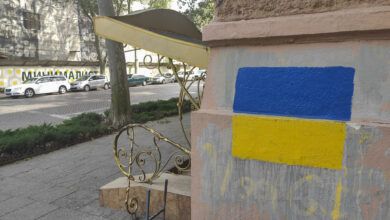Azov Regiment: Ukraine’s most controversial defenders

By Luis Lidón
Kharkiv, Ukraine, Jun 25 (EFE).- The Azov Regiment has been back in the spotlight after its role in the Donbas war in 2014. Russian media uses the group as a prime example of the need to “denazify” Ukraine, while the regiment says that Russians are “the real Nazis.”
After leading the resistance of the Azovstal steel plant in the southern port city of Mariupol, new Azov troops have been training this week on the fringes of Kharkiv, a city located just 40 kilometers from the Russian border, as attacks have intensified in recent days.
“I don’t listen to what Russian propaganda says, so I don’t care what they say,” one commander, who goes by the name Gor, tells EFE. “Our ideology is love for our country.”
“Now the world can see who acts like a Nazi occupier, who thinks like a Nazi, and who does Nazi things,” adds the 30-year-old, who used to own a cafe.
Gor says Russia is unable to accept “the independence and national discourse of other countries” that were under Moscow’s sphere of influence.
SYMBOL OF RESISTANCE
The Azov Regiment, which was created in 2014 to fight pro-Russian forces in Donbas, is a unit of the National Guard and receives orders from the Ukrainian military.
For many in Ukraine, their brave defense of the Mariupol steel mill for over 80 days has made them a symbol of resistance.
The Donetsk People’s Republic says it is working with Russia to set up a court to determine whether Azovstal fighters committed “Nazi crimes.”
“Glory always has two faces and that is the price we pay,” says Gor. “This happens because for eight years the world had its eyes closed to what Russia was doing in Donbas.”
Dozens of soldiers are undergoing marksmanship training with automatic weapons and grenade launchers in the suburbs of Kharkiv.
The regiment members do not show their faces to the media and when Gor speaks to the camera, he sports a balaclava.
There is no doubt that some uniformed men harbor ultra-nationalist ideals, but the recruits are very young boys, many of them teenagers, who have been drawn to the unit owing to its recent fame.
One group of young men tells EFE about their dream of destroying a Russian tank, and the Azov units have the means to do so.
There are also some unexpected characters. One recruit claims to be a Buddhist, smokes a pipe and wears a headscarf. Another has an anarchist tattoo.
The group recently stopped using the Nazi Wolfsangel symbol, used by the SS in Nazi Germany and which resembles a swastika on a yellow background.
They have replaced it with three swords in the shape of a trident, the Ukrainian coat of arms.
FAR-RIGHT ORIGINS
The regiment was created by members of the far-right to fight pro-Russian separatists in eastern Ukraine.





